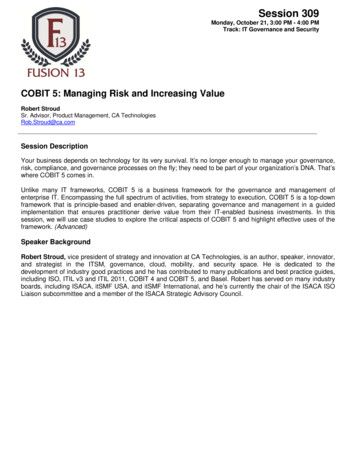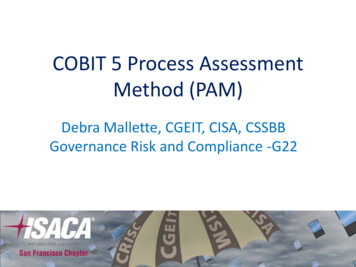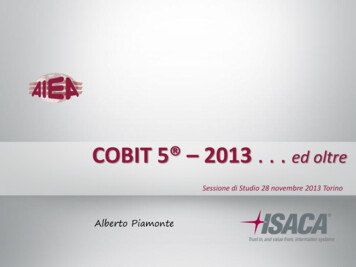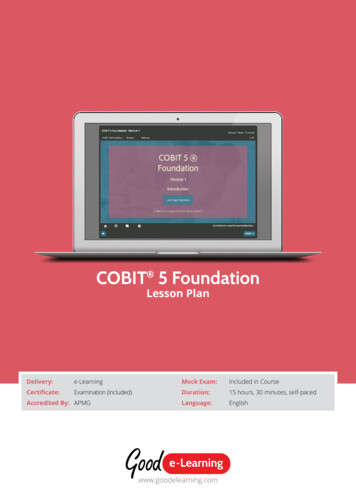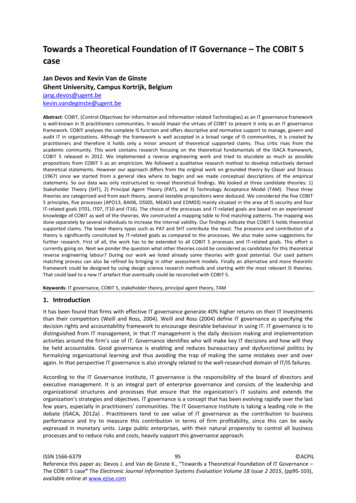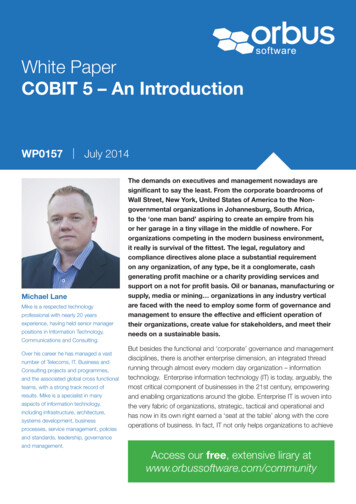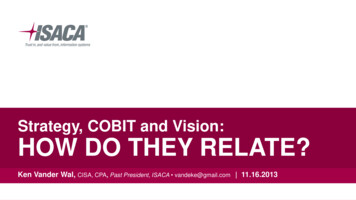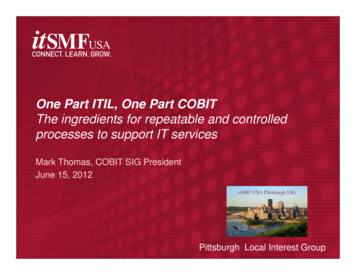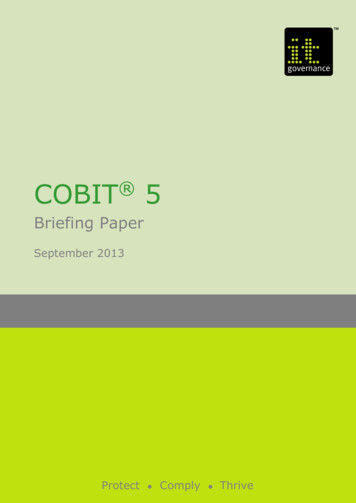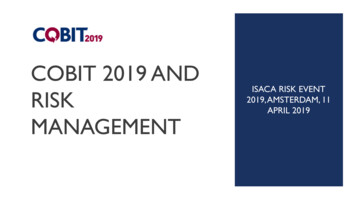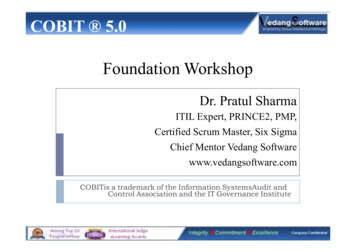
Transcription
COBIT 5.0Foundation WorkshopDr. Pratul SharmaITIL Expert, PRINCE2, PMP,Certified Scrum Master, Six SigmaChief Mentor Vedang Softwarewww.vedangsoftware.comCOBITis a trademark of the Information SystemsAudit andControl Association and the IT Governance Institute
COBIT 5:A Business Framework forthe Governance and ManagementofEnterprise IT
PurposeTo confirm that a candidate has sufficient knowledge and understandingof the COBIT 5 Guidance and Managementof enterprise IT, create awareness with their businessexecutives and senior IT Management ; assess the currentstate of their Enterprise IT with the objective of scopingwhat aspects of COBIT 5 would be appropriate toimplement. Foundation level training and certificate is also aTheprerequisite for the following training and certificate coursesCOBIT 5 Implementation Training & Certificate COBIT 5Assessor Training & Certificate
Target Audience BusinessManagementChief Executives IT/IS Auditors Information Security and IT Practitioners Consultants IT/IS Management oLooking to gain an insight into the Enterprise Governance ofITand looking to be certified as a COBIT Implementer orAssessor
High Level Learning OutcomesThe candidate should understand the key principles and terminology withinCOBIT 5. Specifically the candidate should know andunderstand : The major drivers for the development of a Framework. The business benefits of using COBIT 5. The COBIT 5 ProductArchitecture. The IT management issues and challenges that affect enterprises. The 5 Key Principles of COBIT 5 for the governance andmanagementof Enterprise IT How COBIT 5 enables to be governed and managed in a holistic manner for the entire enterprise. Understandthe key concepts in a Process Capability Assessment How the COBIT 5 Processes and theProcess Reference Model(PRM) help guide the creation of the 5 Principles and the7 Enablers.
Structure of the MaterialThe material is structured in 5 Learning Area Modules Based on two specific COBIT 5 Guides The COBIT 5 ‘Business Framework for the Governance andManagementof Enterprise IT’. SupplementaryGuide on Process Capability with extracts from theCOBIT 4.1 and COBIT 5 PAM’s (ProcessAssessment Model). Some aspects of the Enabling Process Guide have been used asexamplesfor more detailed ‘walk through’where appropriateTipsandNotes have been providedin each guide. Tips and Notes have been provided in each guide
Exam Requirement and Preparation Examrequirements : 50 Questions40 minutesClosedbook50% pass required Exam preparation :Approximately 2 hoursComprises syllabus reviewTest Questions
Do you have anyQuestions ?
Chapter 1Overviewof COBIT 5
Major drivers for COBIT 5Provide more stakeholders a say in determining what they expectfrom information and related technology Addressthe increasing dependency of enterprise success on externalbusiness and IT parties such as outsourcers, suppliers, consultants, clients, cloud and other service providers.Deal with theamount of information, which has increasedsignificantly. Deal with much more pervasive IT; it is more and more an integralpart of the business. Providefurther guidance in the area of innovation and emergingtechnologies. Coverthe full end-to-end business and IT functional responsibilities.Get better control over increasing user-initiated and user-controlledIT solutions
Major drivers for COBIT 5Achieve enterprise:–Value creation through effective andinnovative use of enterprise IT– Business user satisfaction with IT engagement and services– Compliancewith relevant laws, regulations, contractual agreements andinternal policies– Improvedrelations between business needs and IT objectivesConnect to, and, where relevant, align with, other major frameworksand standards, such as Information Technology InfrastructureLibrary (ITIL ), The Open Group Architecture Forum (TOGAF ),Project, Management Body of Knowledge (PMBOK ), Projects INControlled Environments 2 (PRINCE2 ), Committee of SponsoringOrganizations of the Treadway Commission (COSO) and theInternational Organization for Standardization (ISO) standards. Integrate all major ISACA frameworks and guidance, with a primaryfocus on COBIT, Val IT and Risk IT as one single framework
Benefits Information is the business currency of the 21st Century––––Information has a life cycle: it is created, used, retained,disclosed and destroyedTechnology plays a key role in these actions.Technology is becoming pervasive in all aspects of businessand personal life.Every form of enterprise needs to be able to rely on qualityinformation to support quality executive decisions!
Enterprise BenefitsEnterprise and their executives strive to: Maintain quality information to support business decisions. Generate business value from IT-enabled investments i.e.achieve strategic goals and realize business benefits througheffective and innovative use of IT. Achieve operational excellence through reliable and efficientapplication of technology. Maintain IT-related risk at an acceptable level. Optimize the cost of IT services and technology.How can these benefits be realized to create enterprisestakeholder value?
Stakeholder Value vernance and maintenance of information and technology(IT) assets.Enterprise boards, executives and management have toembrace IT like any other significant part of the business.External legal, regulatory and contractual compliancesrequirements related to enterprise use of information andtechnology are increasing, threatening value if breached.COBIT 5 provides a comprehensive framework that assistsenterprises to achieve their goals and deliver value througheffective governance and management of enterprise IT.
Benefits COBIT 5 : Definesthe starting point of governance and managementactivities with the stakeholder needs related to enterpriseIT. Creates a more holistic, integrated and complete view ofenterprise governance and management of IT that isconsistent, provides end to end view on all IT-relatedmatters and provides a holistic view. Creates a common language between IT and business forthe enterprise governance and management of IT. Is consistent with generally accepted corporate governancestandards, and thus helps to meet regulatory requirements.
Business Needs Enterprises are under constant pressure to:–Increase benefits realization through effective and innovation ofenterprise IT ––––Generate business value from new enterprise investment with asupportingIT investment.Achieve operational excellence through application of technology.Maintain IT related risk at an acceptable levelContain cost of IT services and technologyEnsure business and IT collaboration, leading to businesssatisfaction with IT engagement and servicesComply with ever increasing relevant laws, regulations andpolicies.
The COBIT 5 Format SimplifiedCOBIT 5 directly addresses the needs of the viewer fromdifferent perspectives.Development continues with specific practitioner guides–– COBIT 5 is initially in 3 volumes:1.2.3.The FrameworkProcess Reference GuideImplementation GuideCOBIT 5 is based on: ––5 principles and7 enablers
COBIT 5 Product Family
COBIT 5 Product FamilyThe COBIT 5 product family includes the following products: COBIT 5 (the framework) COBIT 5 enabler guides, in which governance and management enablersare discussed in detail. These include:– COBIT 5: Enabling Processes– COBIT 5: Enabling Information (in development)– Other enabler guides (check www.isaca.org/cobit) COBIT 5 professional guides, which include:–COBIT 5 Implementation– COBIT 5 for Information Security (in development)– COBIT 5 forAssurance (in development)– COBIT 5 for Risk (in development)– Other professional guides (check www.isaca.org/cobit) A collaborative onlineenvironment, which will be available to support theuse of COBIT 5
COBIT 5 Mapping Summary
COBIT 5 Mapping Specifies ISO/IEC 38500 ITILv3 the following 5 areas and domains are covered by ITILv3: Asubset of processes in the DSS domainAsubset of processes in the BAI domainSome processes in theAPO domainISO/IEC 27000 ISO’s 6 principles map to COBIT 5Security and IT- related processes in domainsEDM,APO and DSSSome monitoringof security activities in MEAISO/IEC 31000 Risk management related activities in EDM andAPO
COBIT 5 Mapping Specifies TOGAF (The Open Group Architecture Framework)TOGAF componentsof the architecture board and governanceareas.Resource related processes in EDMEnterprisearchitecture processes ofAPO PRINCE2 Programmeand project managementprocesses in the BAI domainPortfoliorelated processes in the APO domain CMM1 Some organizational and quality related processes in the APO domainApplication building and acquisition related processes in BAI
Do you have anyQuestions ?
Chapter 2COBIT 5 PRINCIPLES
COBIT 5 Principles
Principle 1: Meeting Stakeholder NeedsEnterprises have many stakeholders Governance is about NegotiatingDecidingamongst different stakeholder’value interests Consideringall stakeholderswhen making benefit , resource andrisk assessment decisions For each decision , ask:For whom are the benefits? Who bears the risk? What resourcesare required?
Principle 1: Meeting Stakeholder Needs Enterprises exist to create value for their stakeholders ValueCreation :realizing benefits at an optimal resource cost whileoptimizing risk.
Principle 1: Meeting Stakeholder Needs StakeholderNeeds have to be transformed into an enterprises actionablestrategy The COBIT 5 Goals Cascade is the mechanism to translate Stakeholder Needsinto specific , practical and customized goalsThe COBIT5 goals cascade allows the definition of priorities for- Implementation- Improvement- Assuranceof enterprise governanceof ITIn practice , thegoals cascade: Defines relevant and tangible goals and objectives at various levels ofresponsibilityFilters the knowledge base of COBIT 5,based on enterprise goals to extractrelevant guidance for inclusion in specific implementation , improvement orassuranceprojectsClearly identifies and communicateshow enablers are used to achieveenterprise goals
COBIT 5 Goals Cascade
COBIT 5 Goals CascadeStep 1.Stakeholder Drivers Influence StakeholderNeedsStep 2.Stakeholder Needs Cascade to EnterpriseGoalsStep 3.Enterprise Goals Cascade to IT-relatedGoalsStep 4.IT-related Goals Cascade to Enabler Goals
COBIT 5 Goals Cascade Step 1. Stakeholder Drivers Influence Stakeholder Needs Stakeholderneeds are influenced by a numberof drivers, e.g., strategychanges,a changing business and regulatory environment,and newtechnologies. Step 2. Stakeholder Needs Cascade to EnterpriseGoals Stakeholderneeds can be related to a set of generic enterprise goals. Theseenterprise goals havebeen developedusing the balanced scorecard (BSC)dimensions,and they represent a list of commonlyused goals that anenterprise may define for itself. Although this list is not exhaustive, mostenterprise-specific goals can be mappedeasily onto oneor more of the genericenterprise goals.COBIT 5 defines 17 generic goals,which includes the following information: The BSC dimension underwhich theenterprise goal fits Enterprise goals The relationship to the three main governance objectives—benefits realization,risk optimization and resource optimization. (‘P’stands for primaryrelationship and ‘S’for secondary relationship, i.e., a less strong relationship.)
COBIT 5 Goals Cascade Step 3. Enterprise Goals Cascade to IT-related Goals Achievement of enterprise goals requires a numberof IT-related outcomes,which are represented by the IT-related goals. IT-related stands for informationandrelated technology,and the IT-related goals are structured along thedimensionsof the IT balanced scorecard (IT BSC). COBIT 5 defines 17 ITrelated goals. Step 4. IT-related Goals Cascade to Enabler Goals Achieving IT-related goals requires the successful application and useof anumberof enablers. Enablers include processes, organizational structures andinformation, and for each enabler a set of specific relevant goals can bedefined in supportof the IT-related goals.
COBIT 5 Internal Stakeholders
COBIT 5 External Stakeholders
Principle 2:Covering the Enterprise End-to-End COBIT5 addresses the governance and managementof information and related technology from anenterprise wide, end-to end perspective COBIT5:- Integrates governance of enterprise IT into enterprisegovernance- Covers all functions and processes within theenterprise- Does not focus only on the ‘IT Function’
Principle 2:Covering the Enterprise End-to-End This--means that COBIT 5:Integrates the governance of enterprise IT into enterprisegovernance andCovers all functions and processes required to govern andmanage enterprise information and related technologieswherever that information is processed.COBIT 5 addresses all relevant interval and external ITservices as well as external and internal business processes.
Principle 2:Covering the Enterprise End-to-End
Principle 2:Covering the Enterprise End-to-EndMain elements of the governance approach: Governance Enablers comprising- The organizational resources for governance- The enterprise’s resources- A lack of resources or enablers may affect theability of the enterprise to create value Governance Scope comprising- The whole enterprise- an entity, a tangible or intangible asset ,etc .
Principle 2:Covering the Enterprise End-to-End Governance roles , activities and relationshipsdefine Whois involved in governanceHowthey are involvedWhatthey do andHowthey interactCOBIT 5 defines the difference between governance and managementactivities in Principle5
Principle 3:Applying a Single Integrated Framework COBIT 5: Aligns with the latest relevant standards and frameworks Is complete in enterprise coverage Provides a basis to integrate effectively other frameworks ,standards and practices used Integrated all knowledge previously dispersed overdifferent ISACA frameworks Provides a simple architecture for structuring guidancematerials and producing a consistent product set
Principle 3:Applying a Single Integrated Framework
Principle 4:Enabling a Holistic Approach
Principle 4:Enabling a Holistic ApproachEnablers:1.2.3.4.5.6.7.Principles ,policies and frameworkProcessesOrganizational structureCulture,ethics and behaviorInformationServices ,infrastructure and applicationsPeople ,skills and competencies
Principle 4:Enabling a Holistic ApproachCOBIT 5 defines a set of enablers to support the implementationof comprehensive governance and management system forenterprise IT.COBIT 5 enablers are: Factors that ,individually and collectively, influence whethersomething will work Driven by the goals cascade Described by the COBIT 5 framework in seven categories
COBIT 5 Enabler Dimensions: All enablers have a set of common dimension that:- Provide a common ,simple and structured way to dealwith enablers- Allow an entity to manage its complex interactions- Facilitate successful outcomes of the enablers
COBIT 5 Enabler Dimensions:
The Common Dimensions for Enablers: Stakeholders—Each enabler has stakeholdersStakeholders can be internal or external , all having their own, sometimes conflicting, interests Stakeholders’needs translate toenterprise goals, which in turntranslate to IT-related goals Goals—Each enabler has a number of goals, and enablers provide value by the achievementof these goals. Goals can be defined in terms of: Expected outcomes of the enablerApplicationor operation of the enabler itself. The enabler goals are the final step in the COBIT 5 goals cascade.Goals can be further split up in different categories:– Intrinsic quality—The extent to which enablers work accurately, objectively andprovide accurate, objective and reputable results– Contextual quality—The extent to which enablers and their outcomes are fit forpurpose given the context in which they operate. For example, outcomes should be relevant,complete, current, appropriate, consistent, understandable and easy to use.– Access and security—The extent to which enablers and their outcomes are accessibleand secured, such as: Enablers are available when,and if,needed. Outcomes are secured, i.e., access is restricted to those entitled and needing it.
The Common Dimensions for Enablers: Lifecycle—Each enabler has a life cycle, from inception through anoperational/useful life until disposal. This applies to information, structures,processes,policies, etc. The phases of the life cycle consist of:– Plan (includes concepts developmentand concepts selection)– Design– Build/acquire/create/implement– Use/operate– Evaluate/monitor– Update/disposeGood practices—Foreach of the enablers,good practices can be defined. Goodpractices supportthe achievement of the enablergoals. Goodpracticesprovideexamplesor suggestions on howbest to implement the enabler, andwhat work productsor inputs and outputsare required. COBIT 5 providesexamplesof good practices for someenablers provided by COBIT 5 (e.g.,processes).For otherenablers, guidance from otherstandards,frameworks,etc., can be used.
Enabler Performance ManagementEnterprises expect positive outcomesfrom theapplication and useofenablers. To manage performance of the enablers,the following questions will have to be monitored and thereby subsequentlyanswered —based on metrics—on a regular basis: Are stakeholder needs addressed? Are enabler goals achieved? Is the enabler life cycle managed? Are good practices applied? first two bullets deal with the actual outcomeof the enabler.TheThe metrics used to measure to what extent thegoals are achieved canbe called ‘lag indicators’.The last two bullets deal with the actual functioning of the enableritself, and metrics for this can be called ‘lead indicators’.
Principle 5:Separating Governance and Management TheCOBIT 5 framework makes a clear distinctionbetween governance and management Governance and Management Encompass different types of activities Requiredifferent organizational structures Servedifferent purposes COBIT5 :Enabling Processes differentiates theactivities associated with each domain
Principle 5:Separating Governance and Management
COBIT 5: Process Reference Model
Governance & ManagementGovernance ensures that stakeholder needs, conditionsand options areevaluated to determine balanced, agreed-on enterprise objectives to beachieved; setting direction through prioritisationand decision making;and monitoring performance and compliance against agreed-ondirection and objectives.Mostly, governance is the responsibilityof the board of directorsunder The leadership of the chairperson.Management plans, builds, runs and monitors activities in alignmentwith the direction set by the governance body to achieve the objectives.Mostly, management is the responsibilityof the executivemanagement underthe leadership of the CEO.
Governance & ManagementGovernance ensures that stakeholder needs, conditions and optionsare: Evaluated to determine balanced ,agreed -on enterpriseobjectives to be achieved Setting direction through prioritization and decisionmaking Monitoring performance ,compliance and progressagainst agreed direction and objectives (EDM)Management plans, builds, runs and monitors activities inalignmentwith the direction set by the governance body to achieve the enterprise objectives (PBRM)
Chapter 3COBIT 5 IMPLEMENTATIONGUIDANCE
COBIT 5 ImplementationISACA has developed the COBIT 5 Framework to helpenterprises implement sound governance enablers.Implementing good GEIT almost impossible without engaging aneffective governance framework.Best practices and standards are also available to underpin COBIT 5.However, frameworks, best practices and standards are usefulonly if they are adopted and adapted effectively.There are challenges that need to be overcome and issues that needto be addressed if GEIT is to be implemented successfully.COBIT 5 implementation provides guidance on how to dothis .
Enterprise Int & Ext EnvironmentUnderstanding the Enterprise Internal and ExternalEnvironment as they apply to change management such as : Ethics and culture Applicable laws, regulations, policies Mission, vision and values Governance policies and practices Business plans and strategic intensions Operating model Management style Risk appetite Capabilities and available resources Industry practices
Key Success factors Topmanagement providing the direction and mandate forthe initiative as well as on-going commitment All parties supporting the governance and managementprocesses to understand the business and IT objectives Ensuring effective communication and enablement of thenecessary changes Tailoring COBIT and other supporting good practices andstandard to fit the unique context of the enterprise and Focusing on quick wins and prioritizing most beneficialimprovements that are easiest to implement.
Seven Phases –Implementation Life Cycle Whatare the drivers ?Where are we now? Where do we want to be ? What needs to be done ? How do we get there? Did we get there? How do we keep the momentum going ?
COBIT 5 Implementation
COBIT 5 Implementation PhasesPhase1 starts with recognizing and agreeing to the need for an implementationor improvement initiative. It identifies the current pain points and triggers andcreates a desire to change at executive management levels.Phase 2 is focused on defining the scopeof the implementation or improvementinitiative using COBIT’s mapping of enterprise goals to IT-related goals to theassociated IT processes, and considering howrisk scenarios could alsohighlight key processes on which to focus.An assessment of the current state is thenperformed, and issues or deficiencies are identified by carrying out a processcapability assessment.During phase 3, an improvement target is set, followed by a more detailedanalysis leveraging COBIT’s guidance to identify gaps and potential solutions.Some solutions may be quick wins and others morechallenging and longerterm activities. Priority shouldbegiven to initiatives that are easier to achieveand those likely to yield the greatest benefits.
COBIT 5 Implementation PhasesPhase 4 plans practical solutions by defining projects supported by justifiableBusiness cases. A change plan for implementation is also developed. A wellDeveloped business case helps to ensure that the project’s benefits are identifiedand monitored.In phase 5, theproposedsolutions are implementedinto day-to-daypractices.Measures can be defined and monitoring established, using COBIT’s goals andmetrics to ensurethat business alignment is achieved and maintained andperformancecan bemeasured. Success requires the engagement anddemonstrated commitment of top management as well as ownership by theaffected business and IT stakeholders.Phase 6 focuses on the sustainableoperation of the new or improved enablersand the monitoring of the achievement of expected benefits.During phase7, the overall success of the initiative is reviewed, furtherrequirements for the governance or management of enterprise IT are identified,and the need for continual improvement is reinforced.
Phase 1:What are the Drivers ? Initiatethe programme Establish desire to change Recognize need to act
Phase 1:What are the Drivers ? Needfor new or improved IT governance organization isusually recognized by pain points or trigger events. Board and executive management should : Analyze pain points to identify root causeLook for opportunities during trigger events The goal of this phase of the lifecycle includes:Outlining the businessIdentification of stakeholders and roles & responsibilitiesITgovernance program “wake-up call” and kick-offcommunications.
Typical Pain PointsFailed IT initiativesRising costs Perception of low businessvalue for IT investments Significant incidents relatedto IT risk (e.g. data loss) Service delivery problems Failure to meet regulatory orcontractual requirements Audit findings for poor ITperformance or low servicelevels Hidden and /or rogue ITspending Resources waste throughduplication or overlap in ITinitiatives Insufficient IT resources IT staff burnout/dissatisfaction IT enabled changes frequentfalling to meet businessneeds (late deliveries orbudget overruns) Multiple and complex ITassurance efforts Board members or seniormanagers that are reluctantengage with IT.
Relevant Trigger Events Merger,acquisition ordivestitureShift in market,economy orcompetitivepositionChangein business operatingmodel or sourcingarrangementsNew regulatory or compliancerequirements Significant technology changeor paradigm shift An enterprise wise governancefocus or projectAnew CIO,CFO,COOExternal audit or consultantassessmentsAnew business strategy orpriority By using pain points or trigger events as the launching point for ITGovernance initiatives; the business case for GEIT improvements canberelated to issues being experienced which will improve buy-intothebusinesscase
Phase 2:Where are We now ? Definethe problems and opportunities [Programme management]Understand the pain points that have been identified as governanceproblems Take advantages of trigger events that provide opportunity forimprovementForm a powerful guiding team [change enablement] Knowledge of business environment Insight into influencing factorsAssess the current state [continual improvement lifecycle attribute] Identify theIT goals in respect to enterprise goalsIdentify themost important processesUnderstand management risk appetiteUnderstand the maturity of existing governanceRelated processes
Phase 3:Where Do We Want To Be? Define the roadmapDescribe thehigh level change enablement plan and objectives Communicate Develop a communication strategyCommunicate thevisionArticulate the rationaleand benefits of the changeSetthe tone at the top Define desired visiontarget state and perform gap analysisDefinethe target for improvementAnalyze the gapsIdentify potentialimprovements
Phase 4:What Needs To Be Done? Develop program plan Empower role players and identify quick wins Prioritize potential initiativesDevelopformal and justifiable projectsUse plans that include contribution and programobjectivesHigh benefit , easy implementationsshould come firstObtain buy-in by key stakeholders affected by the changeIdentifystrengths in existing processes and leverage accordingly.Design and build improvements Plot improvementsonto a grid to assist with prioritizationConsider approach,deliverables , resourcesneeded , costs, estimatedtime scales, project dependenciesand risks.
Phase 5:How Do We Get There ? Execute Execute projects according to an integrated program planProvide regular update reports to stakeholdersDocuments and monitor the contribution of projects whilemanaging risks identified Enable the planoperation and useBuild on the momentum and credibility of quick winsPlan cultural and behavioral aspects of the broader transitionDefine measures of success Implement improvementsAdopt and adapt best practices to suit the enterprise’s approachto policies and process changes
Phase 6:Did We Get There? Realize benefits Embed new approaches Monitorthe overall performanceof the program against business caseobjectivesMonitorand measure the investment performanceProvide transition from project mode to business as usual modeMonitor whether new roles and responsibilities have been taken onTrackand assess objectives of the change response plansMaintain communicationand ensure communicationbetweenappropriatestakeholders continuesOperated and measure Set targets for each metricMeasure metrics against targetsCommunicateresults and adjust targets as necessary
Phase 7:How Do We Keep MomentumContinual improvements – keeping the momentum is critical tosustainment of the lifecycle Review the program benefits Sustain Review programeffectiveness througha programreview gatheredConsciousreinforcement(reward achievers)Ongoingcommunication campaign (feedback on performance)Continuoustop management commitmentMonitor and evaluate Identifynew governanceobjectives based on programexperienceCommunicatelessons learned and further improvementrequirementsforthe next iteration of the cycle
Making the Business Case Importance of a good business case :The importance of a business case cannot be overstated. An appropriatelevel of urgency needs to be instilled and the keystakeholders should be aware of the risk of not taking action.Aninitiative should be owned by a sponsor(senior), involve all keystakeholders, and be based on a business case.Initiallythis can be a high- level business case dealing with the strategic benefits and costs and then progress to a more detailedbusiness case. It is a valuable tool available to management inguiding the creation of business value.
Characteristics of Good Business Case At a minimum a Business case should include : The business benefits that will be realizedThe business changes requiredThe investments neededThe on-going IT operating costsConstraints and dependencies delivered from the riskAssessmentRoles, responsibilities and accountabilities relative to otherinitiative.How the investment will be monitored.
Chapter 3COBIT 5 ENABLERS
The COBIT 5 Enterprise Enablers
Recap Principle 4 :Enabling a Holistic Approach:Enablers1.2.3.4.5.6.7.Principles, policies and frameworksProcessesOrganizational structuresCulture, ethics and behaviorInformationServices, infrastructure and applicationsPeople, skills and competencies
Recap Principle 4 :Enabling a Holistic Approach:COBIT5 enabler dimensions : All enablers have a set of common dimensions that : Provides a common, simple and structured way to deal withenablers A
In phase 5, theproposedsolutions are implementedinto day-to-daypractices. Measures can be defined and monitoring established, using COBIT’s goals and metrics to ensurethat business alignment is achieved and maintained and performancecan bemeasured. Success requires the enga
